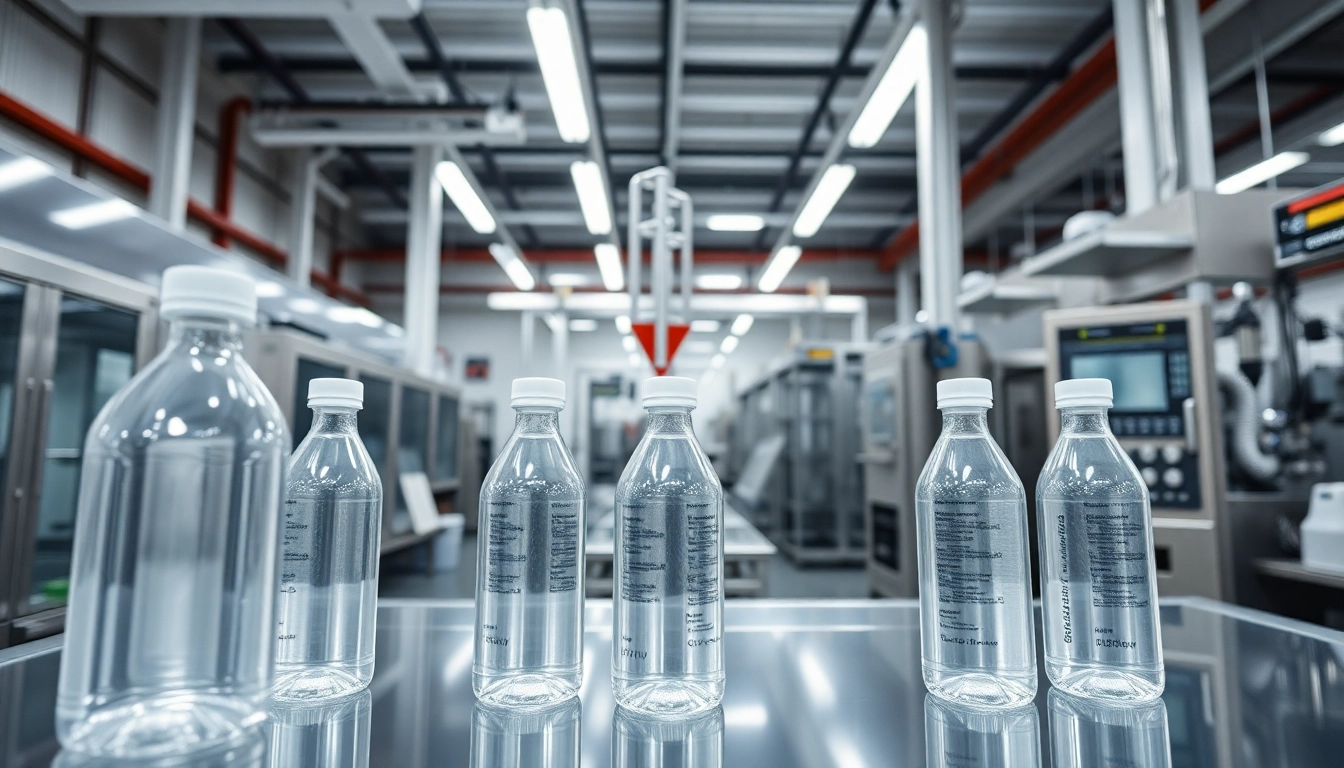Introduction to Polyethylene Bottles and Their Benefits
Polyethylene bottles are among the most versatile and widely used plastic packaging solutions across multiple industries. Known for their durability, lightweight nature, and chemical resistance, these containers are integral to packaging food, beverages, chemicals, cosmetics, and household products. When selecting packaging options, understanding the properties, advantages, and applications of polyethylene bottles is essential for businesses aiming to optimize their supply chain and product presentation. For deeper insights and to explore a range of high-quality polyethylene bottles, visit polietilen şişe from industry-leading suppliers.
Understanding Polyethylene Bottle Production
The production of polyethylene bottles involves a sophisticated process that ensures the final product meets industry standards for safety, durability, and functionality. Typically, manufacturing begins with polymerization, where ethylene monomers are transformed into polyethylene via high-pressure or low-pressure processes. The resulting polyethylene resin is then melted and molded into various shapes through blow molding or extrusion techniques.
Blow molding, particularly, is favored for producing bottles, as it allows for precise control over wall thickness and shape. In this process, compressed air inflates a molten polyethylene parison within a mold, creating the final hollow container. Advanced techniques also enable the production of customized bottles with specific capacities, neck finishes, and structural features tailored to client needs.
Advantages of Using Polyethylene Bottles in Packaging
The popularity of polyethylene bottles is largely rooted in their advantageous properties, which make them suitable for a broad spectrum of applications:
- Lightweight: Their minimal weight reduces transportation costs and makes handling easier, especially in large-volume shipping.
- High Durability: Resistant to impact, cracking, and puncturing, polyethylene bottles withstand rough handling during transit and storage.
- Chemical Resistance: Polyethylene exhibits excellent resistance to acids, alkalis, and detergents, making it ideal for chemical packaging.
- Cost-Effectiveness: Low manufacturing costs combined with high-volume production make these bottles an economical choice for manufacturers.
- Transparency and Flexibility: Clear polyethylene allows consumers to visually inspect contents; the material’s flexibility facilitates various design innovations.
- Recyclability: Polyethylene is recyclable, supporting sustainable packaging initiatives when disposed of properly.
These benefits collectively contribute to increased efficiency and customer satisfaction, positioning polyethylene bottles as a top choice across sectors.
Common Industries Utilizing Polyethylene Bottles
Due to their versatile characteristics, polyethylene bottles are employed in numerous industry sectors:
- Food and Beverage: Bottles for water, juices, sauces, oils, and syrups.
- Chemical Industry: Containers for cleaning agents, pesticides, and industrial chemicals.
- Cosmetics and Personal Care: Bottles for shampoos, lotions, perfumes, and creams.
- Pharmaceuticals: Packaging for medicinal liquids and health-related products, adhering to safety standards.
- Household Products: Detergents, disinfectants, and other cleaning supplies.
The ability to customize size, shape, and closure options ensures that polyethylene bottles meet specific functional requirements in each industry.
Choosing the Right Polyethylene Bottle for Your Business
Factors to Consider When Selecting a Polyethylene Bottle
Selecting the optimal polyethylene bottle involves evaluating multiple factors:
- Capacity and Volume: Choose the appropriate size to balance product shelf life, logistics, and consumer convenience.
- Neck Finish and Opening: Compatibility with caps, spouts, and dispensing systems.
- Material Type: HDPE (High-Density Polyethylene) vs. LDPE (Low-Density Polyethylene) for different applications based on strength and flexibility.
- Design and Shape: Ergonomic, aesthetic, and functional considerations for branding and user experience.
- Production Standards: Ensuring compliance with ISO, CE, and industry-specific certifications to guarantee quality and safety.
Size, Shape, and Capacity Options
Polyethylene bottles come in a wide array of sizes and shapes to suit diverse needs:
- Small bottles (50–250 ml) ideal for cosmetics, samples, and essential oils.
- Medium containers (250–1,000 ml) for beverages, sauces, and cleaning products.
- Large bottles (>1 liter) for industrial chemicals, bulk liquids, and household cleaning supplies.
Design variations include ergonomic grips, slim profiles for shelf optimization, and customizable neck dimensions for specific cap types—factors that enhance end-user convenience and product compatibility.
Quality Standards and Certification
For businesses aiming to uphold safety and quality benchmarks, choosing suppliers with recognized certifications—such as ISO 9001 for quality management and ISO 22000 for food safety—is crucial. High-quality polyethylene bottles should also adhere to local and international regulations concerning food contact and chemical resistance. Certifications not only ensure product reliability but also facilitate market access and consumer trust.
Applications and Customization of Polyethylene Bottles
Designing Custom Polyethylene Bottles for Specific Products
Customization begins with understanding the end product’s unique needs. For instance, bottles for cosmetic serums may require narrow necks and sophisticated labeling areas, while industrial chemical containers demand reinforced design for chemical resistance. Advanced printing and labeling techniques enable branding integration directly onto the bottles, increasing shelf appeal.
Innovative Uses in Food, Chemicals, and Cosmetics
The adaptability of polyethylene bottles opens avenues for innovative applications:
- Infused water bottles with ergonomic shapes promoting active lifestyles.
- Leak-proof containers for essential oils with tamper-evident caps.
- Chemical-resistant tanks for industrial cleaning agents with embossed safety warnings.
- Custom-color bottles with textured surfaces for premium cosmetic products.
Ongoing R&D efforts focus on integrating features like UV protection for sensitive contents and ergonomic dispensing mechanisms.
Integrating Safety Features and Labels
Proper labeling and safety features—including tamper-evident seals, child-resistant caps, and hazard symbols—are vital for regulatory compliance and consumer safety. UV-resistant coatings and barrier layers can also extend product shelf life. Clear, durable labels that withstand environmental factors are essential for branding and informative purposes.
Environmental Impact and Sustainability of Polyethylene Bottles
Recycling and Reusability of Polyethylene Bottles
Polyethylene bottles are highly recyclable, contributing significantly to sustainability initiatives. Proper collection and processing can lead to the production of new bottles or other plastic products, reducing waste and conserving resources. Reusability is also a key factor, with many bottles designed for multiple use cycles when cleaned appropriately.
Reducing Carbon Footprint in Manufacturing
Manufacturers are increasingly adopting eco-friendly production methods, such as utilizing renewable energy sources, optimizing material usage, and adopting closed-loop recycling systems. Innovations like biodegradable polyethylene variants or bio-based resins are on the horizon, promising further reductions in environmental impact.
Future Trends Toward Eco-Friendly Packaging
Industry trends show a growing shift toward sustainable packaging—embracing circular economy principles and eco-design strategies. Collaborations between material scientists, packaging designers, and environmental groups aim to develop biodegradable or easily recyclable polyethylene bottles that meet functional requirements without harming ecosystems.
Buying and Partnering with Reliable Suppliers
Questions to Ask Before Purchasing Polyethylene Bottles
When sourcing polyethylene bottles, consider inquiries about:
- Material certifications and compliance with safety standards.
- Production capacity and lead times.
- Customization options and design flexibility.
- Pricing structures for bulk orders.
- Environmental practices and sustainability commitments.
Ensuring Delivery, Quality, and Cost Efficiency
Selecting a reputable supplier involves evaluating past client feedback, testing product samples, and verifying logistics capabilities. Long-term partnerships foster consistency, better pricing, and collaborative innovation. Ensuring transparent communication and comprehensive after-sales support enhances overall procurement efficiency.
Building Long-Term Business Relationships
Developing enduring relationships with suppliers depends on mutual trust, quality assurance, and flexibility. Regular audits, shared sustainability goals, and clear contractual terms contribute to a resilient supply chain capable of adapting to market changes.



